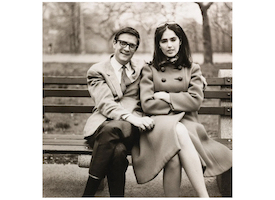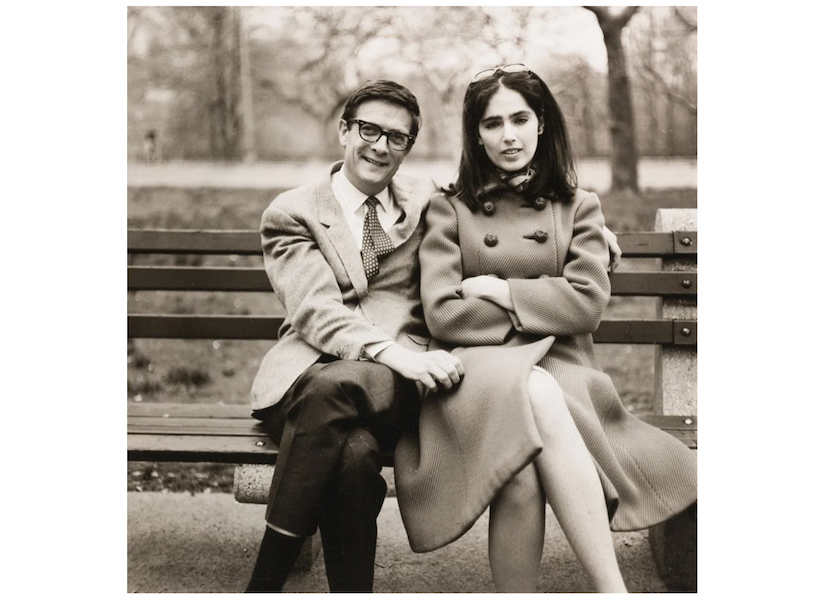
A Diane Arbus photograph of a couple sitting on a bench earned €13,000 (about $14,094) plus the buyer’s premium in June 2022. Image courtesy of OstLicht Photo Auction and LiveAuctioneers.
NEW YORK — Eager to escape the constraints and self-perceived embarrassments of growing up in an affluent family, Diane Arbus (nee Nemerov) married at the age of 18. She was introduced to photography by her husband Allan Arbus, a photographer for the US Army Signal Corps. Early in their marriage, the couple became involved in fashion photography.
Diane Arbus (1923-1971) is best known for what would now be called “street photography.” She focused solely on black-and-white images, and embraced the role of serving as the final arbiter of what the viewer sees while also highlighting the ephemeral nature of a moment that lives on only in her photographs.
She was drawn to marginalized people and those existing on the fringes of society, such as circus, sideshow and drag performers, little people and transgender people. Having a keen eye for what made a compelling image, she also captured everyday moments with children, people sitting on a bus, families at home or a couple sitting on the bench.
Even in her ordinary images, though, there is often something just below the surface, indicating all is not what it seems. A key example is one of her photos of a couple sitting on a park bench. They could be any happy couple, and the man smiles into the camera and reaches for his wife, but her body language is different. She’s not smiling, and she crosses her arms over her chest in a protective gesture. A vintage silver print photo of this image made $14,094 plus the buyer’s premium in June 2022 at OstLicht Photo Auction. It depicts Color Field painter Kenneth Noland and his wife, Stephanie Gordon, a psychologist. The two had lived together for nearly two years by the time Arbus took the photo in 1966. They married in April 1967, but divorced in June 1970.
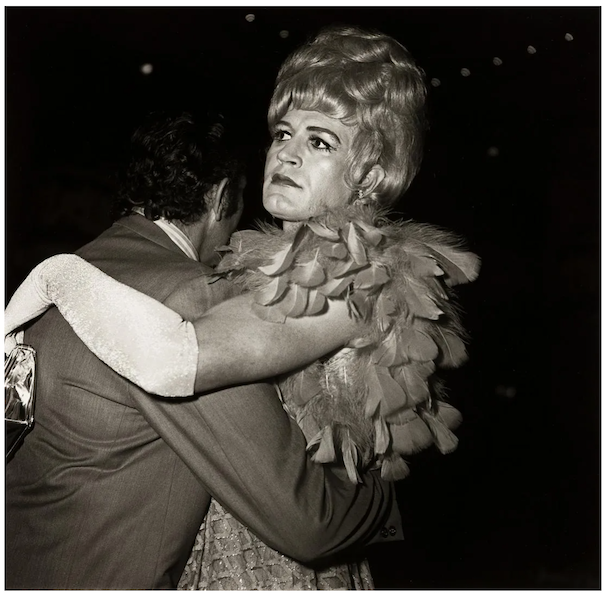
Arbus’s images of people living unusual lifesyles are her most iconic and sought after, even those that were printed after her death – a situation that is not typically the case in the market of prints and multiples. After the Stonewall uprising in New York City in 1969, gay and drag culture emerged from the shadows, and men were legally allowed to dance with each other. A photo she took of two men dancing at a New York drag ball in 1970 earned $40,000 plus the buyer’s premium in April 2021 at Swann Auction Galleries. Arbus died by suicide in 1971 and photographer Neil Selkirk, who was taking a master class she taught in the period leading up to her death, was authorized by her estate to print her work for a MoMA retrospective. The estate also gave him permission to print some of her other images. They typically perform well, including the silver print of the two men, which was printed in 1972.
Her legacy lies in how she changed the prevailing attitudes on what constituted so-called “appropriate” subject matter for photography, as well as her approach to the people she featured. By befriending her sitters instead of keeping them at bay to maintain objectivity, her work takes on added psychological intensity. Her style yielded some of the most unique and surprising images of this era.

In July 1970, Arbus was on a magazine assignment in Maryland and walked into a carnival, where she found many people whose jobs and lifestyles were fascinating to her, as they were very different from her own. Growing up in a well-to-do family, Arbus didn’t face adversity or have to struggle, so perhaps that was part of the attraction. On the carnival grounds, she photographed several performers, including a woman sword swallower who had albinism and a heavily tattooed man. An image of the latter, which was printed in the early 1970s, sold for $15,000 plus the buyer’s premium in March 2021 at Swann Auction Galleries.
After her death, some argued that her voyeuristic photos were exploitative. The relationships she built with many of her sitters, such as Eddie Carmek, the giant who she met 10 years before she photographed him, or others who she met up with repeatedly, instead speak to a different purpose. She wasn’t a paparazzo, aiming to grab the perfect shot and be gone in a flash; she wanted to get to know the person she was photographing. Upon close inspection, her photos reflect an empathetic relationship with their subjects, confirmed in many of her own writings released long after her passing.
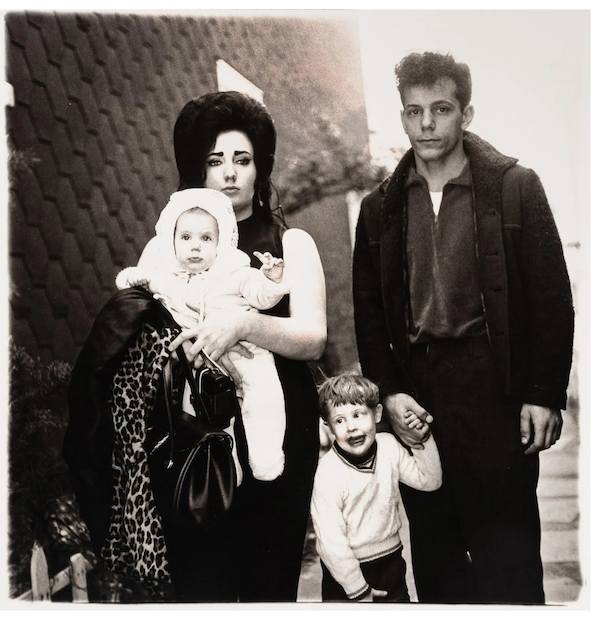
In one image in particular, A young Brooklyn family going for a Sunday outing, N.Y.C, the photo came about after Arbus met a fashionable young woman, Marylin Dauria, on a subway in 1966. They talked, and Arbus scheduled a photo shoot at Dauria’s home with her, her husband and their two children. The image of the family about to take a Sunday drive was originally published in the New York Times in 1968; a 1973 print from Selkirk realized $10,000 plus the buyer’s premium in December 2022 at Hindman.
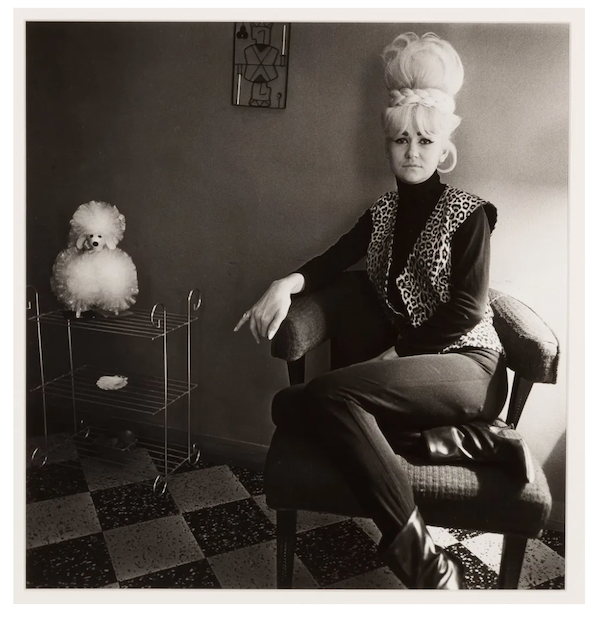
Arbus was captivated by people who lived outside of mainstream society or who took on unconventional jobs. In 1970, only about 20 percent of bartenders in the United States were women (in earlier decades, many cities had banned women from this line of work). In keeping with her preference for shooting her sitters in places where they felt most comfortable, Arbus took a photo titled Lady Bartender at Home with a Souvenir Dog, New Orleans, LA., 1964. A circa-1972 print of that image brought $10,500 plus the buyer’s premium in September 2017 at Cottone Auctions. With nothing but the photo’s title to give away the woman’s occupation, the photo, printed by Selkirk, is still striking for the confident and direct gaze of the sitter, whose poufy coiffure is matched by that of her poodle.
Arbus’ work has been hotly debated and studied, and while she is no longer here to explain it, she justified her outside-the-box oeuvre by saying, “I really believe there are things nobody would see if I didn’t photograph them.”


